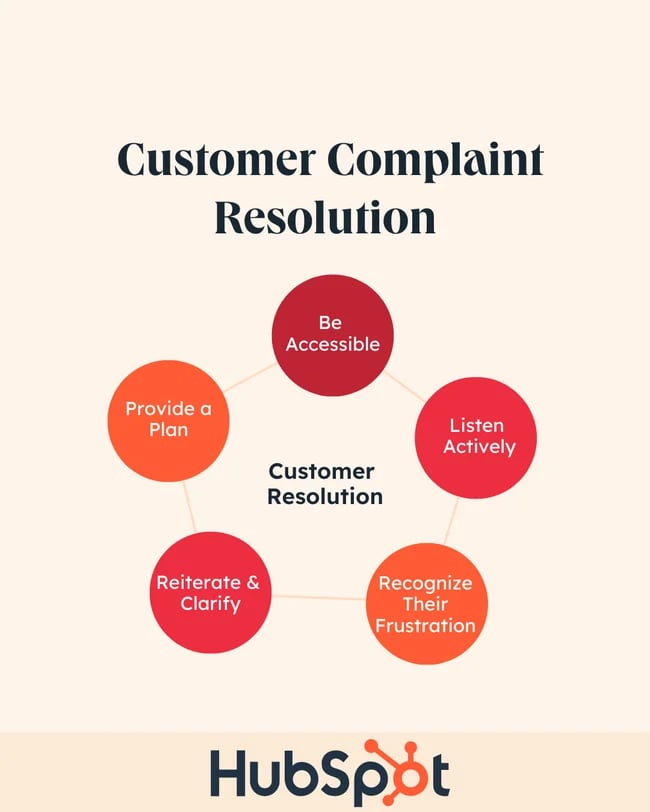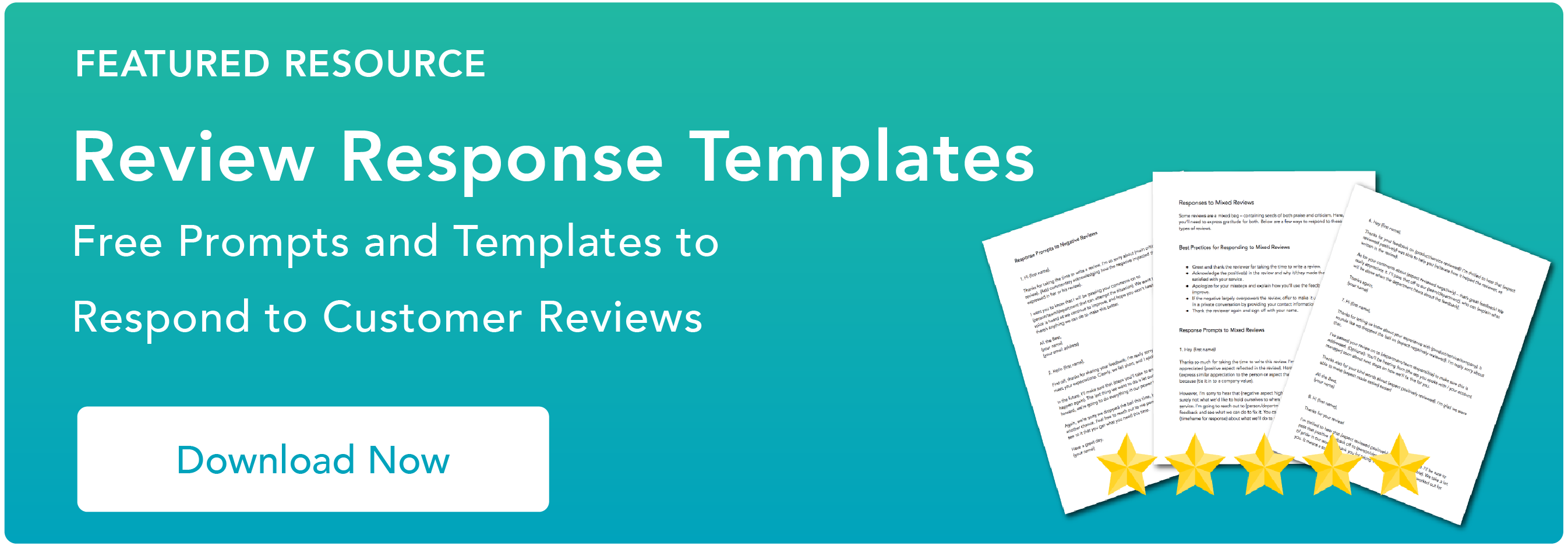Your customers are your purest form of quality control. Without their approval, your business doesn't grow and succeed. So, when customer complaints roll in, it's important to hear them out because these are opportunities to improve the customer experience and prevent potential churn.

No matter which industry you're in, you're going to deal with customer complaints. Even if your business doesn't make a mistake, one of your customers will eventually hit a roadblock that leads them to your customer service team. These are the situations where your service reps make or break the customer's journey.
If you want to increase customer retention, you need to prepare your reps for scenarios they'll face with difficult or frustrated customers. In this post, we'll break down the different types of customers complaints as well as the steps your team can take to resolve each one.
Customer Complaints
Customer complaints are pieces of feedback that point out problems with your company's product or services. These are opportunities for your business to improve its internal processes and create a better customer experience.
Below are a few common customer complaints you can expect your service team to encounter.
.png)
Free Review Response Templates
20 prompts to help you respond to customer complaints and comments.
- Positive Reviews
- Negative Reviews
- Mixed Reviews
- False/Slanderous Reviews
1. Long Wait on Hold
If your team works in a call center, Average Time on Hold (ATH) is one of your most important call center metrics. Customers want fast answers and can't afford to spend their afternoon with a phone glued to their ear. In fact, studies show that after about two minutes, customers are likely to hang up the phone and 34% of those customers won't call back. That means you can potentially lose a third of your customer base just because you didn't pick up the phone fast enough.
How to resolve this customer complaint:
Long hold times indicate two problems. First, it could mean that your customer demand is too high for your customer service team. In this case, you should consider hiring more reps to meet the needs of your call center. In the meantime, your reps should apologize for the long wait times and work to ensure first call resolution.
The other issue may be that your call center lacks automation. Call center software can provide your service team with features that streamline operations and complete tasks automatically. By adopting this technology, you can optimize your team's production by removing menial tasks from their day-to-day workflow. This should reduce hold time complaints and create a more satisfying service experience.
2. Unavailable or Out of Stock Product
It's usually a good sign when a product goes out of stock, but if it stays out of stock, customers can become impatient for its return. They may demand a special order or repeatedly call for product updates. This typically indicates a time-sensitive need for your product which should be fulfilled immediately.
How to resolve this customer complaint:
As a customer service rep, you might not have any say in when a new shipment will be ordered. Reps should report these issues to their managers who can notify both sales and product management teams. Service reps should encourage customers to remain patient and let them know that they'll reach out when the shipment arrives. This type of proactive customer service will assure customers that you're aware of their time-sensitive needs.
3. Making Customers Repeat Their Problem
Customers hate repeating their problems to your reps. This happens when they're either transferred to new reps or dealing with an agent who isn't paying close attention. When customers have to describe their issue multiple times, it's both a frustrating and time-consuming experience.
How to resolve this customer complaint:
If a customer is complaining about having to repeat their issue, the best step you can take is to stop transferring their call. Even if you need to connect the customer with a specialist, reach out to that agent internally and see if you can relay the advice. This may be more tedious, but it will meet the customer's immediate needs.
A long-term solution to this problem is to invest in help desk software. A help desk can manage and distribute incoming service requests to the most ideal agents. That way, your customers are connected directly to reps who are best suited to resolve their problems.
4. Uninterested Service Rep
Whether it's their tone, personality, or even just the time of day, some customers simply won't get along with your customer service reps. When a rep fails to meet their needs, some customers think it's due to a lack of interest in their case. Sometimes this is true, other times customers have expectations that are higher than what your team can provide. Regardless of where the fault lies, when your reps fail to appear invested, your business's reputation takes the hit.
How to resolve this customer complaint:
When dealing with this type of customer complaint, reps should consider what they can do to provide above-and-beyond customer service. Every business has protocol, but it's sometimes worth bending the rules if that means preventing customer churn. At the very least, reps should pay attention to their tone and body language to ensure they're displaying a motivated and attentive demeanor.
If a customer does report an issue with a rep, management should always investigate the issue. Managers should give their reps the benefit of the doubt but try to get every possible detail. Rather than criticizing the rep's approach, look for opportunities to teach the agent about preventing these types of situations. If these issues continue to occur, it may be time to take more severe actions.
5. Poor Product or Service
When your product breaks, you can expect the customer to complain. In some cases, the product isn't broken, rather, the customer doesn't understand how to use it. Other times, customers aren't a good fit for your product or service, but they blame your company for failing to fulfill their needs. No matter how customers arrive at this conclusion, your team needs to know how to prevent them from turning to your competitors.
.png)
Free Review Response Templates
20 prompts to help you respond to customer complaints and comments.
- Positive Reviews
- Negative Reviews
- Mixed Reviews
- False/Slanderous Reviews
How to resolve this customer complaint:
If the product isn't broken, educate the customer. Find out what their goals and needs are, then teach them how they can use the product to achieve success. If the product is broken, provide options for immediate replacement and try to determine how it broke. If it was user error, gently point out to the customer how they can avoid this outcome in the future.
For a long-term solution, consider adopting customer feedback tools to survey customers about your product. You can use NPS® surveys to measure customer satisfaction and learn how you can enhance your product's features. These feedback tools provide both quantitative and qualitative data that you can use to improve product development.
6. No First Call Resolution
When customers call your service team, they expect their issue to be resolved after the first call. Studies show that 67% of customer churn is avoided if the service request is fulfilled during the first interaction. While that doesn't mean you should hold customers on the phone, it does mean that they should be pursuing first call resolutions.
How to resolve this customer complaint:
When your reps begin a customer interaction, they should make note of the case's urgency. If the customer has time-sensitive needs, try to resolve the case in the first call but don't waste time repeating steps or researching irrelevant information. If your reps don't have the answer, they should ask politely to follow up and explain why that process will yield a faster resolution.
One way you can improve first call resolution rates is to add self-service support options to your company's website. Tools like community forums and a knowledge base can help customers find their own solutions and avoid service calls altogether. This creates a more enjoyable and convenient service experience for your customers.
7. Lack of Follow Up
When you do have to follow up on a case, customers will often have different expectations for follow-up communication. Some customers will expect an ongoing chain of updates while others will be more patient. If your reps aren't consistently clear about response times, your customers may think you've forgotten about their case.
How to resolve this customer complaint:
If you do have to follow up on a case, your service rep should make communication expectations clear. Ask the customer if the proposed frequency works for them, and if not, establish a system that works for both your rep and the customer. Your reps should be dedicated to customer needs, but customers have to give your reps space to work on the issue independently. If your reps are constantly providing updates, customers will wait longer for solutions.
If your team is having trouble keeping track of follow up, you should consider adopting a ticketing system. Ticketing systems document incoming requests and make it easier for you to manage active service cases. And, you can integrate it with your CRM so tickets will be directly attached to customer profiles.
8. New Product or Feature Request
This one isn't necessarily a complaint but is something that customer service teams encounter on a daily basis. If your product or service doesn't meet all of your customers' needs, they'll ask if they can propose a new product or feature. While some of these are helpful, most fulfill specific use-cases that don't apply to the bulk of your customer base.
How to resolve this customer complaint:
In these cases, you should have a self-service space where your reps can direct these requests to. These product requests are valuable, but you can't afford to have reps spending their day listening to customer ideas. Create a forum where customers can post these ideas for your product development team to see. This will give your team an opportunity to comment and engage with customers who want to improve your product.
How to Handle Customer Complaints
When handling a constant stream of customer needs daily, it can be overwhelming trying to formulate a plan to resolve the complaints coming in. However, it’s not impossible. Empower your service teams to do their best work by following these steps.
1. Collect feedback and look for patterns.
The first step in addressing customer complaints is to dig into the complaints you have received. Using a tracking software will make this process much easier as you’ll be able to quickly access feedback and metrics like average call times.
Next look for patterns. Does a portion of your customers have similar complaints? For example they may say longer call hold times, or report a bug with your product.
Whatever the complaints are, you’ll need to examine the feedback you’re getting first. You can’t fix what you don’t know.
2. Talk to your service team.
Next, share this feedback with your service team. Discuss their pain points solving for the customer and gather any additional insights. Are they overwhelmed with the volume of calls and tickets received? Do they have the tools needed to provide the best service possible? Could your current service processes be improved?
Your service team is on the frontlines with customers every day so their feedback is invaluable for improving the customer experience.
.png)
Free Review Response Templates
20 prompts to help you respond to customer complaints and comments.
- Positive Reviews
- Negative Reviews
- Mixed Reviews
- False/Slanderous Reviews
3. Determine the root causes of the problem.
Now that you have a good grasp of the issues your customers are facing, it’s time to address the main causes.
For example, if customers report long call wait times, it could be that they are calling during peak times of the day when your service team is swamped with higher than normal call volumes.
Did you roll out a new product feature that has a few bugs and is causing consistent complaints across the board? Maybe the details of the new feature were not communicated clearly to customers and are causing friction. Getting to the root of the issues will help you formulate a plan which we’ll cover next.
4. Create a plan to address customer pain points.
Now that you’ve found the main cause of your customers’ dissatisfaction, it’s time to implement a plan to solve the issue.
If the root cause is an issue with your current internal service processes, update them to make them more clear to the team and provide more training if necessary.
Maybe your service team noticed an influx of customers calling for information that could be better communicated with a self-serve FAQ page or similar option. Creating a knowledge base customers can use to resolve their issues may be the best solution for light troubleshooting. This way customers don’t have to wait on hold and it frees up your service rep’s time to handle more complicated service requests.
Next, we'll cover some best practices your service reps can use daily while interacting with customers to improve their experience.
Customer Complaint Resolution
Customer complaint resolution is the process of receiving negative feedback, investigating the cause of the issue, and resolving the problem — all while communicating to the customer in a way that makes them feel heard.
Resolution handling with the goal of turning dissatisfied customers into glowing evangelists of your service experience comes down to these techniques:

1. Be accessible.
If the customer has an issue with your product or service, having to jump through hoops to get it resolved will only create more frustration.
Make it easy to solve issues by providing self-service options and being easy to connect with across channels.
2. Use active listening to understand their complaint.
The best thing you can do for a dissatisfied customer is to actively listen and engage with them.
- Ask clarifying questions.
- Stay focused on their needs.
- Empathize with them.
3. Acknowledge their frustration.
The best thing you can do for a dissatisfied customer is acknowledge their frustration and validate their feelings. Empathy is one of the most important customer service skills, and acknowledging their frustration helps them feel heard and appreciated.
4. Reiterate for clarity and understanding.
Show that you were listening by stating their issue back to them. By doing this, you're confirming your understanding and getting approval from the customer.
5. Seek a first-call resolution.
With more contact attempts in pursuit of a solution comes more friction. With more friction comes more frustration.
For a truly stellar customer experience, all effort should be made to completely resolve the issue during the first call. Not only does it increase customer satisfaction, but it also reduces the load on the support team as a whole.
6. Provide a plan of action.
If you're unable to provide a solution on their first call, set expectations for what comes next.
- Will they hear back from you?
- When?
- What will you be doing in the meantime? (getting necessary information, etc.)
If you know that their problem is one that has no solution due to limitations of your system or some other reason, acknowledge their frustration and detail what actions you're taking based on their feedback (forwarding their concerns to the appropriate department, escalating the ticket, etc.).
Strive to Delight Customers
In the end, not all customer complaints will be resolved to the customer's satisfaction, and some customers may still walk away upset. However, it's up to you to provide a great experience to reduce these instances where you can.
Editor's note: This post was originally published in July 2019 and has been updated for comprehensiveness.
Net Promoter, Net Promoter System, Net Promoter Score, NPS and the NPS-related emoticons are registered trademarks of Bain & Company, Inc., Fred Reichheld and Satmetrix Systems, Inc.











